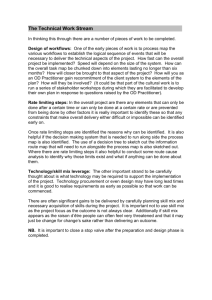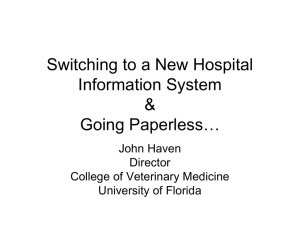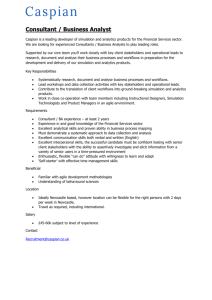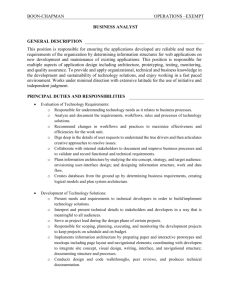Integrated Data Placement and Task Assignment for Scientific Workflows in Clouds ¨
advertisement
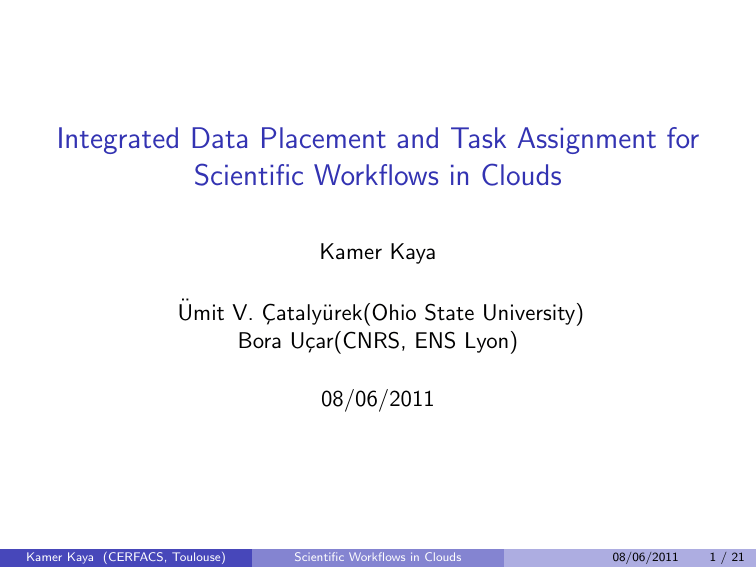
Integrated Data Placement and Task Assignment for
Scientific Workflows in Clouds
Kamer Kaya
Ümit V. Çatalyürek(Ohio State University)
Bora Uçar(CNRS, ENS Lyon)
08/06/2011
Kamer Kaya (CERFACS, Toulouse)
Scientific Workflows in Clouds
08/06/2011
1 / 21
Scientific workflows
Scientific applications → scientific workflows.
Figure: A toy workflow W = (T , F) with N = 5 tasks and M = 4 files.
Kamer Kaya (CERFACS, Toulouse)
Scientific Workflows in Clouds
08/06/2011
2 / 21
Cloud model
K execution sites: S = {s1 , s2 , · · · , sK }
◮
◮
◮
used for storing files and executing tasks,
with different characteristics: storage, computation power, cost etc.,
with different desirabilities.
Figure: A simple cloud and assignment of the tasks and files in toy workflow.
Kamer Kaya (CERFACS, Toulouse)
Scientific Workflows in Clouds
08/06/2011
3 / 21
Notation
size(fi ): size of file fi .
exec(tj ): computational load of a task tj .
The desirability of each site:
◮
◮
◮
desf (sk ): storage desirability of site sk .
dest (sk ): computational desirability of site sk .
PK
PK
k=1 desf (sk ) =
k=1 dest (sk ) = 1.
After the assignment, for each site si , we want
P
size(files(si ))
tj ∈tasks(si ) exec(tj )
P
≈ desf (si ) and
≈ dest (si )
size(F)
tj ∈T exec(tj )
Kamer Kaya (CERFACS, Toulouse)
Scientific Workflows in Clouds
08/06/2011
4 / 21
Costs and loads
Total communication: size(f2 ) + 2 × size(f3 ) + size(f4 )
Computation and storage load for s1 :
P3
P2
size(fi )
i=1 exec(ti )
and P4i=1
P5
i=1 exec(ti )
i=1 size(fi )
Kamer Kaya (CERFACS, Toulouse)
Scientific Workflows in Clouds
08/06/2011
5 / 21
Hypergraph partitioning problem
H = (V, E): a set of vertices V and a set of nets (hyperedges) E.
Weights can be associated with the vertices and costs can be
associated with nets.
◮
◮
w (vi ): weight of a vertex vi ∈ V,
c(nj ): cost of a net nj ∈ E.
A K -way partition Π satisfies the following:
◮
◮
◮
Vk =
6 ∅ for 1 ≤ k ≤ K ,
V
∩
k
S Vℓ = ∅ for 1 ≤ k < ℓ ≤ K ,
k Vk = V.
We use the connectivity - 1 metric with the net costs:
X
cutsize(Π) =
c(nj )(λj − 1)
nj ∈EC
where λj is the number of part nj touches.
Kamer Kaya (CERFACS, Toulouse)
Scientific Workflows in Clouds
08/06/2011
6 / 21
Hypergraph partitioning problem
Figure: A toy hypergraph with 9 vertices 4 nets, and a partitioning with K = 3.
Cutsize (w.r.t. to the connectivity - 1 metric) is c(n2 ) + 2 × c(n3 ) + c(n4 ).
Kamer Kaya (CERFACS, Toulouse)
Scientific Workflows in Clouds
08/06/2011
7 / 21
Hypergraph partitioning problem
A K -way vertex partition of H is said to be balanced if
Wmax ≤ Wavg × (1 + ε)
where Wmax and Wavg are the maximum and average part weights,
respectively, and ε is the predetermined imbalance ratio.
Multi-constraint hypergraph partitioning:
◮
◮
Multiple weights w (v , 1), . . . , w (v , T ) are associated with each v ∈ V.
The partitioning is balanced if
Wmax (t) ≤ Wavg (t) × (1 + ε(t)),
Kamer Kaya (CERFACS, Toulouse)
Scientific Workflows in Clouds
for t = 1, . . . , T .
08/06/2011
8 / 21
Proposed hypergraph model
Given a workflow W = (T , F), we create a hypergraph H = (V, E) as
follows:
We have two types of vertices in V:
1
Task vertices (vi ) which correspond to tasks tj ∈ T
⋆
2
w (vi , 1) = exec(tj ) and w (vi , 2) = 0.
File vertices (vi ) which correspond to files fk ∈ F.
⋆
w (vi , 1) = 0 and w (vi , 2) = size(fk ).
For each file fi ∈ F, we have a net ni ∈ E:
◮
◮
ni is connected to the vertices corresponding to fi itself, and the ones
corresponding to tasks T which use fi .
c(ni ) = size(fi ).
Kamer Kaya (CERFACS, Toulouse)
Scientific Workflows in Clouds
08/06/2011
9 / 21
Integrated file and task assignment
We partition the generated hypergraph H = (V, E) into K parts.
The connectivity - 1 metric is equal to the total amount of file
transfers.
While minimizing the cutsize, we have two constraints:
1
2
dest (si ) values are not exceeded for each execution site si .
desf (si ) values are not exceeded for each execution site si .
Multi-constraint hypergraph partitioning tool is (only) satisfied by
PaToH [Çatalyürek and Aykanat, 1999].
Problem: Non-unit net costs and target part weights are not available
in PaToH v3.1.
Solution: We improved PaToH by implementing these features and
made them available in PaToH v3.2.
Kamer Kaya (CERFACS, Toulouse)
Scientific Workflows in Clouds
08/06/2011
10 / 21
Integrated file and task assignment
Just to remember:
Kamer Kaya (CERFACS, Toulouse)
Scientific Workflows in Clouds
08/06/2011
11 / 21
Integrated file and task assignment
Figure: A simple 3-way partitioning for the toy workflow. The white and gray
vertices represent, respectively, the tasks and the files in the corresponding
workflow.
Kamer Kaya (CERFACS, Toulouse)
Scientific Workflows in Clouds
08/06/2011
12 / 21
Another approach
A similar approach by [Yuan et al., 2010]:
Files are clustered with respect to task usage and assigned to
execution sites.
A task is then assigned to the site having most of its required files.
If a new file is generated, it is assigned to a similar cluster.
We adapted their ideas to our case:
Files are partitioned by using MeTiS
[G. Karypis and V. Kumar, 1998].
Tasks are visited in decreasing order of their execution times.
A task is assigned to a suitable site which has the largest amount of
required files.
Kamer Kaya (CERFACS, Toulouse)
Scientific Workflows in Clouds
08/06/2011
13 / 21
Experimental results
We compared two approaches:
1
2
DP: existing (consecutive) approach.
DPTA: proposed (integrated) approach.
Algorithms are run 10 times and the averages are listed.
Both approaches were fast. For the largest workflow
1
2
DP runs in 7 seconds,
DPTA runs in 3 seconds
on a 2.53 GHz MacBook Pro
Kamer Kaya (CERFACS, Toulouse)
Scientific Workflows in Clouds
08/06/2011
14 / 21
Experimental results: Data set
We used the following workflows from Pegasus web page:
(https://confluence.pegasus.isi.edu/display/pegasus/
WorkflowGenerator)
CYBERSHAKE.n.1000.0, referred to as C-shake in table;
GENOME.d.11232795712.12, referred to as Gen-d,
GENOME.n.6000.0, referred to as Gen-n,
LIGO.n.1000.0, referred to as Ligo;
MONTAGE.n.1000.0, referred to as Montage;
SIPHT.n.6000.0, referred to as Sipht.
We also used three synthetically generated workflows.
Kamer Kaya (CERFACS, Toulouse)
Scientific Workflows in Clouds
08/06/2011
15 / 21
Experimental results: Data set
Name
N
M
C-shake 1000 1513
Gen-d 3011 4487
Gen-n 5997 8887
Ligo 1000 1513
Montage 1000 843
Sipht 6000 7968
wf6k 6000 6000
wf8k 8000 8000
wf10k 10000 10000
# files per
avg min
3
1
3
2
3
2
6
2
7
2
65
2
9
1
9
1
9
1
task
max
5
35
114
181
334
954
18
18
19
# tasks per file
avg min max
2
1
92
2
1 736
2
1 1443
4
1 739
8
1 829
49
1 4254
9
1
17
9
1
17
9
1
17
Table: The data set contains six benchmark workflows (first six in the table) from
Pegasus workflow gallery, and three synthetic ones.
Kamer Kaya (CERFACS, Toulouse)
Scientific Workflows in Clouds
08/06/2011
16 / 21
Experimental results
File imbalance: maxi
1+
!
size(files(si ))
size(F ) −desf (si )
Task imbalance: maxi 1 +
desf (si )
P
t ∈tasks(s ) exec(tj )
P
j
i
−des
(s
)
t i exec(t
)
tj ∈T
j
desf (si )
file transfer
Communication cost: total size(F
)
Kamer Kaya (CERFACS, Toulouse)
Scientific Workflows in Clouds
08/06/2011
17 / 21
Experimental results: real-world workflows
Data
C-shake
Montage
Sipht
K
4
8
16
32
4
8
16
32
4
8
16
32
Average
Kamer Kaya (CERFACS, Toulouse)
Tasks
1.000
1.002
1.005
1.031
1.003
1.063
1.181
1.248
1.000
1.000
1.000
1.001
1.000
DP
Files
1.388
1.388
1.554
2.865
1.007
1.006
1.254
2.108
1.001
1.002
1.030
1.031
1.000
Comm
0.123
0.294
0.613
0.780
0.932
1.564
1.931
2.312
1.223
1.850
3.781
7.224
1.000
Scientific Workflows in Clouds
Tasks
1.199
1.192
1.553
1.932
1.002
1.007
1.023
1.137
1.000
1.003
1.016
1.059
1.124
DPTA
Files Comm
1.619
0.119
1.465
0.489
1.733
0.809
2.670
0.882
1.001
0.564
1.006
0.863
1.121
1.153
2.374
1.568
1.000
0.604
1.004
1.300
1.014
2.923
1.037
5.515
1.048
0.615
08/06/2011
18 / 21
Experimental results: synthetic workflows
Data
wf6k
K
16
32
64
wf8k 16
32
64
wf10k 16
32
64
Average
Tasks
1.008
1.036
1.348
1.007
1.026
1.218
1.003
1.016
1.141
1.000
Kamer Kaya (CERFACS, Toulouse)
DP
Files
1.030
1.030
1.030
1.030
1.030
1.030
1.030
1.030
1.030
1.000
Comm
4.546
5.407
6.032
4.603
5.462
6.066
4.614
5.472
6.095
1.000
Tasks
1.005
1.009
1.130
1.004
1.009
1.099
1.003
1.007
1.176
0.968
Scientific Workflows in Clouds
DPTA
Files Comm
1.002
2.044
1.003
2.765
1.052
3.184
1.002
2.208
1.003
2.975
1.032
3.118
1.001
2.076
1.003
2.757
1.074
3.228
0.989
0.501
08/06/2011
19 / 21
Conclusions
We proposed an integrated approach for assigning tasks and placing
files in the Cloud.
We modeled a scientific workflow as a hypergraph.
We enhanced the PaToH to encapsulate the arising partitioning
problem.
We claim that the proposed approach is extremely effective for
data-intensive workflows.
Dynamic workflows (repartitioning?)
Replication (partitioning with replication?)
Fixed location for files (partitioning with fixed vertices?)
Makespan ?
Kamer Kaya (CERFACS, Toulouse)
Scientific Workflows in Clouds
08/06/2011
20 / 21
References
D. Yuan, Y. Yang, X. Liu, and J. Chen. (2010)
A data placement strategy in scientific cloud workflows.
Future Generation Computing Systems, 26:12001214, October 2010.
Ü. V. Çatalyürek and C. Aykanat. (1999)
PaToH: A multilevel hypergraph partitioning tool, version 3.0.
Technical Report BU-CE-9915, Computer Engineering Department, Bilkent
University, 1999.
G. Karypis and V. Kumar. (1998)
MeTiS: A Software Package for Partitioning Unstructured Graphs, Partitioning
Meshes, and Computing Fill-Reducing Orderings of Sparse Matrices Version 4.0.
University of Minnesota, Department of Comp. Sci. and Eng., Army HPC Research
Center, Minneapolis, 1998.
Kamer Kaya (CERFACS, Toulouse)
Scientific Workflows in Clouds
08/06/2011
21 / 21


